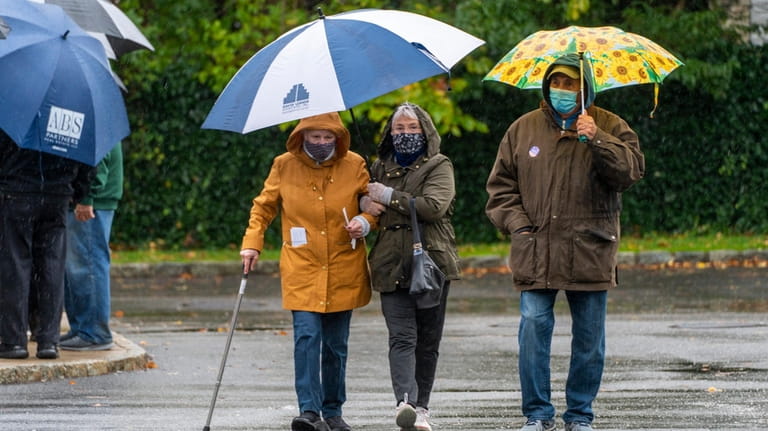Long Island gets older: Census shows median age increased, surpassing state and national stats

Seniors play Bingo at the Smithtown Senior Center. The latest Census says Long Island's population is aging, its median age surpassing the state and country's. Credit: Barry Sloan
Long Island's population has grown older, its median age in 2020 almost two years higher than it was a decade before — surpassing the state and national median age while the ranks of those 65 and older also continued to increase.
For Long Island overall, the median age in 2020 was 42, up from 40.4 in 2010: For Nassau County, it was 41.9 in 2020, compared with 41.1 in 2010; and for Suffolk County, the 2020 median age was 42, more than two years higher than its 2010 median of 39.8 years old.
The aging of the Long Island's population, along with the country's, are the result of a few primary factors, officials said, such as the aging of the Baby Boom generation and the decrease in the number of children being born. And one expert noted that Long Island and New York has seen an out-migration of young people, and that an aging population was not just occurring in the United States.
“What’s happened around the world is … more or less at the same time … the U.S. birthrate was going down, [and] the birthrate in other countries was as well," said Warren Sanderson, a professor emeritus of economics at Stony Brook University, who has written extensively about population aging. That has meant, he said, the United States was getting international migrants that are older than in decades past. "Usually, the migrants are in their early 20s, and there are fewer and fewer people in their early 20s in the sending countries now," he said of places from which international migrants originate.
For New York State, the median age was 39 in 2020, up from 38 in 2010. The median age for the United States overall was 38.8, up from 37.2 in 2010.

Long Island's population is getting older, driven by a low birth rate and the aging of the Baby Boomer generation, the Census shows. Credit: Randee Daddona
When broken down by race, the "white alone" population on Long Island was the oldest of all groups, with a median age in 2020 of 47.9. For Black or African American alone, it was 37.7; for Asian alone, 38.3; for American Indian and Alaska Native alone, it was 33.8; and for Hispanics and Latinos, which includes people of any race, it was 31.4. Native Hawaiian and Other Pacific Islander alone population was the Island's youngest race group in 2020, with a median age of 30.4.
The data showing the growth in the Island's older adults population comes from the U.S. Census Bureau's 2020 Census Demographic Profile and Demographic Housing Characteristics released Thursday, providing data on age, sex, and race/ethnicity for localities.
The 65 and over population increased 3.8 percentage points on Long Island between 2010 and 2020, rising from 14.3% of the Island's population to 18.1% according to Newsday's analysis of the census data. For New York State, the 65 and over population rose from 13.5% to 16.9% in 2020. And for the United States, the 65 and over group was 16.8% in 2020, up from 13% in 2010.
Experts say age is an important component to help inform public policy decisions.
The Census Bureau also calculated for the nation what it called the "dependency ratio" which the bureau said was "the ratio of the dependent-age population (young or old) to the working age population. The higher this ratio is, the greater the burden of support on working people."
According to Newsday's analysis, the 2020 dependency ratio on Long Island was 63.6 children under 18 and adults age 65 and older for every 100 working-age people ages 18 to 64, which matched the U.S. ratio. That compares to a dependency ratio for the Island of 61.2 a decade earlier.
Jan Vink, a researcher with Cornell University's Program on Applied Demographics, said if the dependency ratio "gets far out of balance, then you have to reduce the number of services you can provide to the older age population."
But Sanderson criticized the dependency ratio as "misleading" and "terrible for a number of reasons. One is it sets a threshold at which we characterize people as old [at] 65. In our day, that's ridiculous," said Sanderson, who is 80 and co-authored a book in 2019 called "Prospective Longevity."
"When you measure things in this way, your measurements are biased and give people the wrong impression," Sanderson continued. "The second thing that's wrong with it is people who turn 65 are often not dependent … People 65 are very active, lots of them are working. There's absolutely no economic or other reason to categorize them as dependent."
Sanderson said research has shown that many older adults are "pro-social" and "want to interact with people." He called on policymakers to recognize that services to older adults are not "one-size fits" all, and should encourage people who want to volunteer to do so, and to provide those who live alone with supportive services so they aren't isolated.
"The most important thing to remember is that older people have lived their whole lives with children, with husbands, with wives — lived their whole lives with people and helping people," he said. "It's important, however we do this, to make sure we support all sorts of different policies to keep older people socially interactive."
